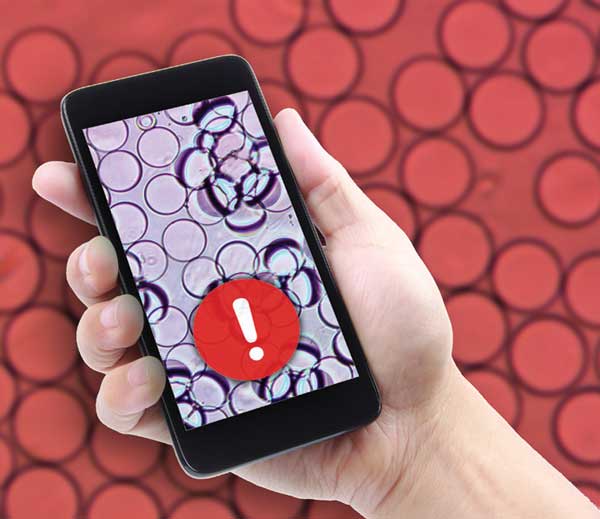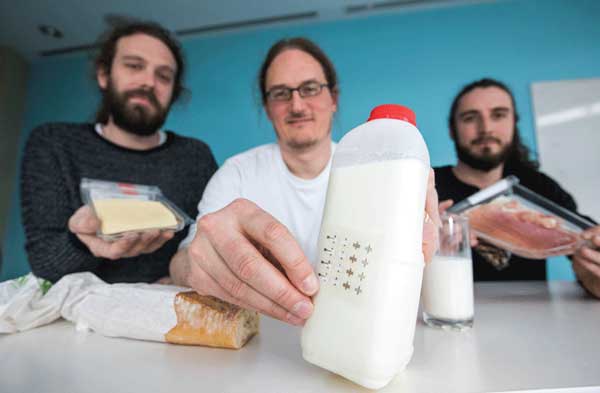Faster, cheaper pathogen detection; Graphene nanomaterials create smart food labels
CUTTING EDGE TECHNOLOGY
 Faster, cheaper method for detecting pathogens
Faster, cheaper method for detecting pathogens
Researchers at MIT, the Max Planck Institute, and Berlin Univ. have developed a new method for detecting foodborne pathogens. The methodology is based on liquid droplets (called Janus emulsions) that can bind to bacterial proteins. This interaction, which can be detected by either the naked eye or a smartphone, could offer a much faster and cheaper alternative to existing food safety tests. The researchers’ work appeared in a paper “Janus Emulsions for the Detection of Bacteria” published in ACS Central Science.
“It’s a brand-new way to do sensing,” declared Timothy Swager, John D. MacArthur Professor of Chemistry at MIT and the senior author of the study. “What we have here is something that can be massively cheaper, with low entry costs.”
Two years ago, Swager’s lab developed a way to easily make complex droplets, including Janus emulsions. These Janus droplets consist of two equally sized hemispheres, one made of a fluorocarbon and the other made of a hydrocarbon. Fluorocarbon is denser than hydrocarbon, so when the droplets sit on a surface, the fluorocarbon half is always at the bottom.
The researchers decided to explore using these droplets as sensors because of their unique optical properties. In their natural state, the Janus droplets are transparent when viewed from above, but they appear opaque if viewed from the side, because of the way that light bends as it travels through the droplets.
To turn the droplets into sensors, the researchers designed a surfactant molecule containing mannose sugar to self-assemble at the hydrocarbon-water interface, which makes up the top half of the droplet surface. These molecules can bind to a protein called lectin, which is found on the surface of some strains of E. coli. When E. coli is present, the droplets attach to the proteins and become clumped together. This changes the orientation of the droplets, so that light hitting them scatters in many directions, and the droplets become opaque when viewed from above.
“We’re using the native molecular recognition that these pathogens use. They recognize each other with these weak carbohydrate-lectin binding schemes,” Swager explained. “We took advantage of the droplets’ multivalency to increase the binding affinity, and this is something that is very different than what other sensors are using.”
To demonstrate how these droplets could be used for sensing, the researchers placed them into a Petri dish atop a QR code that can be scanned with a smartphone. When E. coli are present, the droplets clump together and the QR code can’t be read.
The researchers hope to adapt their new technology into arrays of small wells, each containing droplets customized to detect a different pathogen and linked to a different QR code. This could enable rapid, inexpensive detection of contamination using only a smartphone.
 Graphene nanomaterials create smart food labels
Graphene nanomaterials create smart food labels
In a paper “All-printed thin-film transistors from networks of liquid-exfoliated nanosheets” published in Science, European researchers describe the fabrication of printed transistors consisting entirely of two-dimensional nanomaterials. These 2-D materials, which combine exciting electronic properties with the potential for low-cost production, could unlock the potential for applications such as food packaging that displays a digital countdown to warn you of product spoilage and wine labels that alert you when your white wine is at its optimum chilled temperature.
“In the future, printed devices will be incorporated into even the most mundane objects such as labels, posters, and packaging,” noted Jonathan N. Coleman, a professor at Trinity College Dublin and a corresponding author of the paper. “Printed electronic circuitry (constructed from the devices we have created) will allow consumer products to gather, process, display, and transmit information: for example, milk cartons could send messages to your phone warning that the milk is about to go out-of-date.”
Led by Coleman, the team used standard printing techniques to combine graphene nanosheets as the electrodes with two other nanomaterials, tungsten diselenide and boron nitride, as the channel and separator (two important parts of a transistor) to form an all-printed, all-nanosheet, working transistor.
If you are working on or know of some cutting edge technology that you would like to be featured in this column, please send an email to [email protected].
